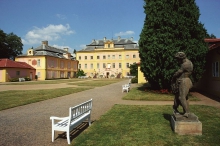The history of the chateau and estate Krásný Dvůr is connected to the history of noble house of Czernin. Plans for reconstruction of what was once their summer house were prepared by the renowned Baroque architect František Maxmilián Kaňka. According to his project the Renaissance fortress was changed to an elegant austere building of transparent shapes. Krásný Dvůr was acquired by a famous member of the Czernin family – Heřman of Chudenice in 1649. As a brave young man he ventured together with Kryštof Harant of Polžice and Bezdružice to the Orient on a dangerous and long journey. In his days a simple Renaissance fortress used to stand on the spot of the present Baroque castle compound. The Czernins had a unique English-style garden built in the 1780s. This is the oldest and largest English park in our country, with an area of 100 ha. After his studies in England the gardener Mr. Födisch created a sophisticated water works on Leskovsky Creek supplying five ponds and an artificial waterfall. Together with the originally planted huge trees this axis creates the basis of this unique park. Several Empire style and romantic garden structures were added later. The Neo-Gothic outlook tower with a chapel is quite rare. The Chateau hosted many famous guests, such as J.W. Goethe, the poet Theodor Körner, the Duchess of Sagan with Count Metternich, and also Josef Dobrovsky. Krásný Dvůr belonged to the Czernin noble house until the occupation, when the Nazis took over. The place was nationalized in 1945. Most rooms open to the public are equipped with contemporary fixtures and fittings, with numerous precious pieces of furniture, china and paintings, and a valuable set of gouache paintings of the chateau from the early 19th century. The chateau is also famous for having been the set of several movies: End of the Old Times, How Poets Like Life and The Hot Summer in Marienbau. Sightseeing tours: • stylish chateau interiors - Czernin collections (Baroque paintings of dog breeds)











































